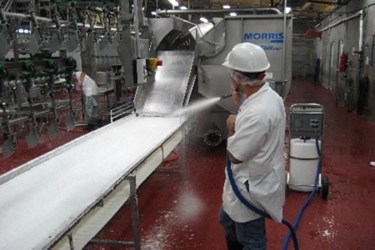6 Ways To Reduce Listeria Contamination In Produce Processing
By Melissa Lind, contributing writer

Listeria contamination is one of the most-common food-safety issues that results in illness and recall. Recent produce contamination events are a reminder that strict attention to cleaning practices is essential in the produce industry.
When most people think of food contamination events, meat, seafood or other animal products immediately come to mind. Despite those events being more common, bacterial contamination of produce presents a unique problem as produce is often eaten raw, putting an even greater burden on the produce processor in terms of contamination avoidance.
New regulations require food-safety programs. However, in many cases actual procedures are left up to the individual processor. Fortunately, some basic principles can help to minimize the chance of a contamination event.
Cleaning Programs
A simple command of “clean the equipment” isn’t adequate. The establishment of a verified cleaning process is not only mandated by law, it is essential to ensure public safety. Any surface that comes into contact with produce should be subject to rigorous cleaning and sanitization, including steam or chemical-based sterilization. When chemical sterilization is used, an adequate decontamination process should also be used.
Testing Programs
Your safety program should include routine testing for food residue. Just because a surface looks clean doesn’t mean it is. Organic matter provides a medium for bacterial growth and all residues should be removed by the cleaning process. Hygiene monitoring for adenosine triphosphate (ATP), a naturally occurring chemical that is present in all living cells, will identify the presence of the residue of organic matter remaining on food-processing equipment.
Pathogen-Specific Testing
A simple swab of the surface, particularly in the corners of food-processing surfaces, can be used in a rapid-identification test to quickly identify the presence of pathogens. Testing specific to Listeria should be performed, but while Listeria is a common contaminant, other pathogens, such as Salmonella and E. coli, should also be included in a routine testing program.
Documentation
Food processors should rely on the practice of “if it isn’t documented, you didn’t do it.” Documentation is the foundation for ensuring adherence to any food-safety program. With routine, thorough documentation, a food-manufacturing plant can identify any missteps that may have occurred and can provide regulatory proof that expected activities are being performed.
Repetition
The actual frequency of cleaning may depend on specific equipment, but a general rule of “more is better” should be used. Your facility’s cleaning processes should specify time periods for cleaning to be repeated and this should be part of your documentation. Whether your firm’s program calls for end of day, shift-change, or mid-shift cleaning, decontamination should also take place any time a production run ends to avoid cross-contamination of shipments or produce types.
Smaller Lot Sizes
Breaking up processing batches into smaller lots can help identify contamination points more easily. Breaking up a large batch shipment into small lot sizes can also help to minimize the impact and cost of a recall as an entire production run may not have to be held or recalled in the event of contamination.
Food-safety processes that involve adequate cleaning and routine testing will reduce risk to both the public in terms of safety and to the processor in terms of quality production. One, single food-contamination event can cost a company significantly more than the cost of implementing preventive measures.
